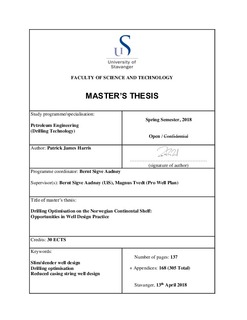| dc.description.abstract | The purpose of this thesis was to attempt to provide evidence that Norway’s drilling fraternity is long overdue for a re-think in the way it drills wells. In so doing, the author has chosen to focus on slim well drilling as a means of reducing drill costs. It was postulated that slim well drilling could lead to much lower drilling investment costs. This body of work therefore focuses on the regulatory, economic and technical implications of slim hole drilling in Norway.
The study examined the historical trends of drilling optimisation, particularly in light of the recent downturn. It was discovered that drilling investment costs in Norway have increased three-fold since the year 2000 with drilling and wells contributing 50% of that overall investment (>NOK100B per year). Whilst there has indeed been some improvement in efficiency since 2014, there is still a major issue with hidden NPT and overall rig crew efficiency. There are, however, some exciting developments in play for slimming down explorations wells in Norway, with the possibility of even drilling with a single casing string being considered.
To attempt to indicate that slim wells are indeed possible, six hypothetical exploration wells were examined. Two in the North Sea, another two in the Norwegian Sea and the remainder in the Barents Sea. These regions were chosen to give the broadest possible outlook for the opportunities and challenges at play for the Norwegian sector. For each region, one conventional well design and one slender well proposal was analysed and despite an absence of some data, realistic assumptions were made based on publically available data from Norwegian operators.
From a technical standpoint, our analysis concluded the following:
• For each conventional well presented, it was technically possible to remove one or two casing strings, with no lost production and well integrity remaining intact;
• The limiting technical factor in slim well design is kick tolerance. All slim hole options required changes to casing set depth and hole size due to kick tolerance;
• Due to recent advances in downhole technology, the use of tools such as alternate-flow through casing shoes mean ECD’s are not the problem they would otherwise be. By under-reaming certain hole sections and using managed pressure drilling, ECD’s can be further reduced, as can annular pressures during cementing;
In assessing the technical merits of slim well drilling, an economic model was developed for each of the six drill proposals. A number of realistic assumptions were made based on ballpark materials pricing and some limited drill cost data from an undisclosed operator. Our economic analysis concluded the following:
• Simply slimming down a well, all casing depths remaining equal may not necessarily be economically beneficial. This will depend entirely on operating time;
• Material cost savings, while significant, only play a minute role in reducing wellbore costs. These savings will fluctuate depending on the operating company’s competitive market advantage in securing lower per-unit material costs;
• The primary cost driver of economically successful slim well drilling is rig crew performance;
The study rounds-up with an expose of the current opportunities and challenges facing industry today. Whilst it is easy to show evidence of the techno-economic merits of slim hole drilling, it was thought prudent to examine the current industry appetite for these sorts of wells, in light of the challenges which need to be overcome before commercialisation of slim hole drilling can occur. The biggest roadblocks currently hindering the commercial success of slim hole drilling are the preventive drilling rig certification costs for new rigs in Norway and the current state of the local OCTG market. A number of recommendations to industry were presented:
• Standardisation of drilling rig certification processes and regulations between Denmark, Norway and the UK (North Sea sector);
• Standardisation of manufacturing, operating and documenting practises across industry;
• The implementation of rig crew performance incentive schemes, which are particularly important given that the economic merits of slim wells hinge on a high performing crew;
• Implementing risk sharing models to ensure a more stable flow of income/expense, as well as reviewing the ways in which rig costs are set;
• “Going digital”. Implementing digital well planning to drive down costs.
In closing, this thesis concludes that slim wells are a lucrative option for Norwegian operating companies, in that they are technically sound for the Norwegian Continental Shelf and economically viable given a prevalence of the conditions outlined above. | nb_NO |

